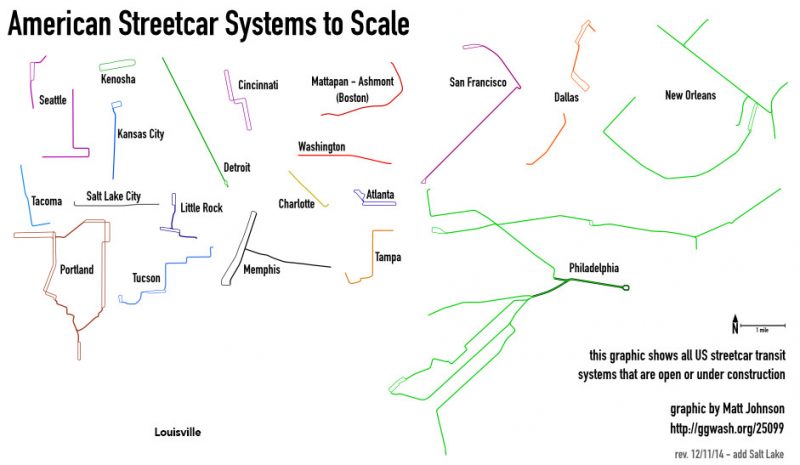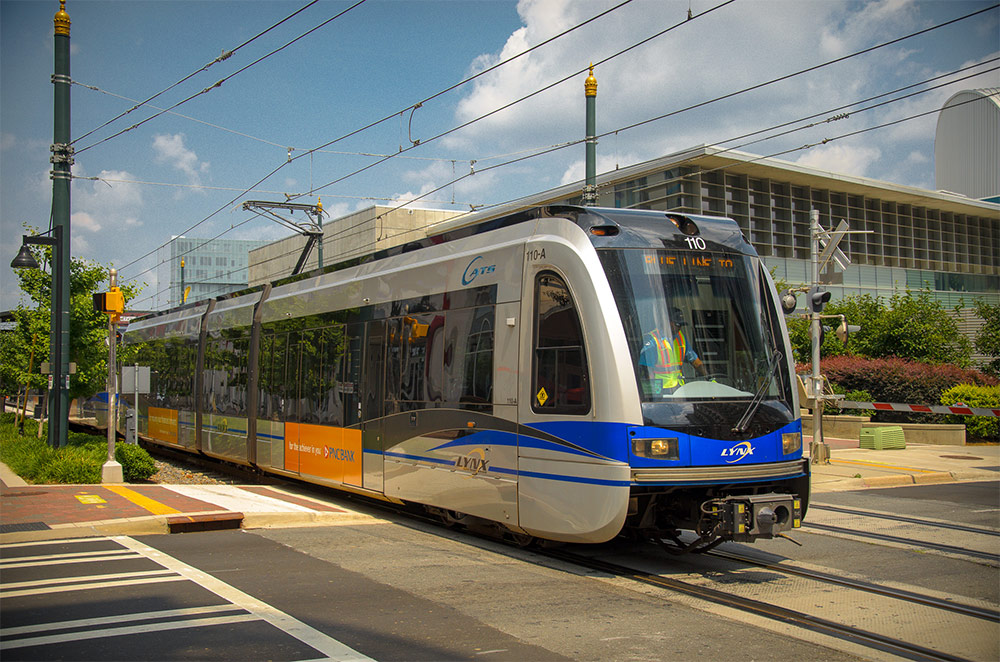The top urbanism blog from our nation’s capital, Greater Greater Washington, recently published a map showing all of the existing or under construction United States streetcar systems at the same scale. We took this opportunity to add Louisville into the mix of 19 cities that includes Memphis, Cincinnati, Kansas City, Charlotte, Little Rock, Atlanta, and others.

Louisville’s streetcar system, in the lower left-hand corner, is shown at the exact same scale as the other cities so you can get a sense of what we’re up against. As should be pretty obvious, Louisville isn’t playing in the same transit league as the cities shown on the chart above. Our city’s once impressive streetcar system was systematically dismantled in the 20th century. There is, however, a citizen-led group—An Old Way Forward—pushing for a modern streetcar line along Fourth Street connecting Downtown Louisville, SoBro, Old Louisville, and the University of Louisville. Follow along with their efforts on Facebook.
Greater Greater Washington noted that Philadelphia and New Orleans’ systems have remained largely unchanged over the decades (The New Orleans St. Charles line started running in the 1830s!) and that some cities like San Francisco have chosen to use “heritage” or old-fashioned streetcars. The site added that newer systems have opted to use modern streetcars—a trend that began with Portland’s system in 2001. Read more about the streetcar systems at Greater Greater Washington.



Like Philadelphia, San Francisco’s core streetcar network remains largely unchanged and is one of the largest in North America. San Francisco’s Muni J,K,L,M, and N lines all date to the early 20th century. It was upgraded in the 80s to “light rail” standards in a new downtown subway portion, but outside the core it still operates like traditional streetcar system in mixed traffic, just with modern, longer streetcars or “light rail” cars. Those 5 lines and the new T Line (which is light rail) are branded Muni Metro. The GGW article did not include the Muni Metro lines in its assessment, which only noted the Market Street line with its vintage streetcars.
I’ve never understood why people are advocating for light rail on 4th st so much. Why not build a line seperated from traffic on Broadway or Main? It will be quite easy to take a lane or two on either street and not effect traffic. You could connect many different neighborhoods to downtown. Show the city what a well designed transit line can accomplish and you stand a better chance of being able to convience people of the advantages to removing parking lanes from 4th street and/or Bardtown Road in order to build high quality lines in the future.
This slate is not clean. There are many erasures of prior efforts to ignite light rail and street cars in Louisville. T2 was a major effort championed by Barry Barker and others to establish a first leg of a
street car system running from Ford Motor and the airport to Main Street downtown. That effort was killed by the competing federal Bridges Project that sucked up all the state funds. In the CART legal challenge to the Bridges Project we wrote:
The 1996 ORMIS Purpose and Need Statement was formed in the same period
and in reaction to, the Transit Authority of River City seeking $ 900 million in federal funding to
complete the Transportation Tomorrow light rail project (“T2”). The TARC Board of Directors
had conducted an extensive public consultation process leading to an agreed route and mode of
fixed rail overhead electric rail car, and approved the project for construction.
In December 2000, Defendants general engineering contractor CTS, created a
proposed light rail cross river connection system alternative for comparative analysis that:
1) did not connect to the proposed T2 light rail system already under engineering review;
2) because of the non-connection, Defendants included construction of a duplicative service
center in Indiana;
3) instead of using available and existing bridge capacity, the alternative required construction of
a new Ohio River rail bridge;
4) To serve the proposed light rail system Defendants proposed 120 new feeder bus routes .
By combining two major projects each over $ 500,000,000 in cost, Defendants
persuaded local politicians there was not enough federal funding for both T2 and the Ohio River
Bridges Mega Project. In 2004, after spending $ 9.9 million on engineering studies to prepare
the Draft EIS, and unable to procure federal funding because state and local political leaders
including Defendants refused to allocate matching funds, the TARC Board cancelled further
development of T2. On May 13, 2004, Metro Mayor Abramson was quoted in the Courier-
Journal, “ The funds are simply not there to build two bridges and light rail.” Currently, transit
ridership is computed to be less than 2% of the total Metro Planning Area trip mode and
expected to remain that way past 2030
It seems like each spring a new group of exuberant urban planners vocalizes a desire for low emissions
energy efficient light rail with its own dedicated right of way to carry commuters past the latest wreck
congestion on the highways. The prospect is they will carry on their musings without mentioning FORD
Motor or TOYOTA, UPS and trucking interest that have control of state transportation policy and spending.
Its like watching an idiot get smacked repeatedly until he stutters.